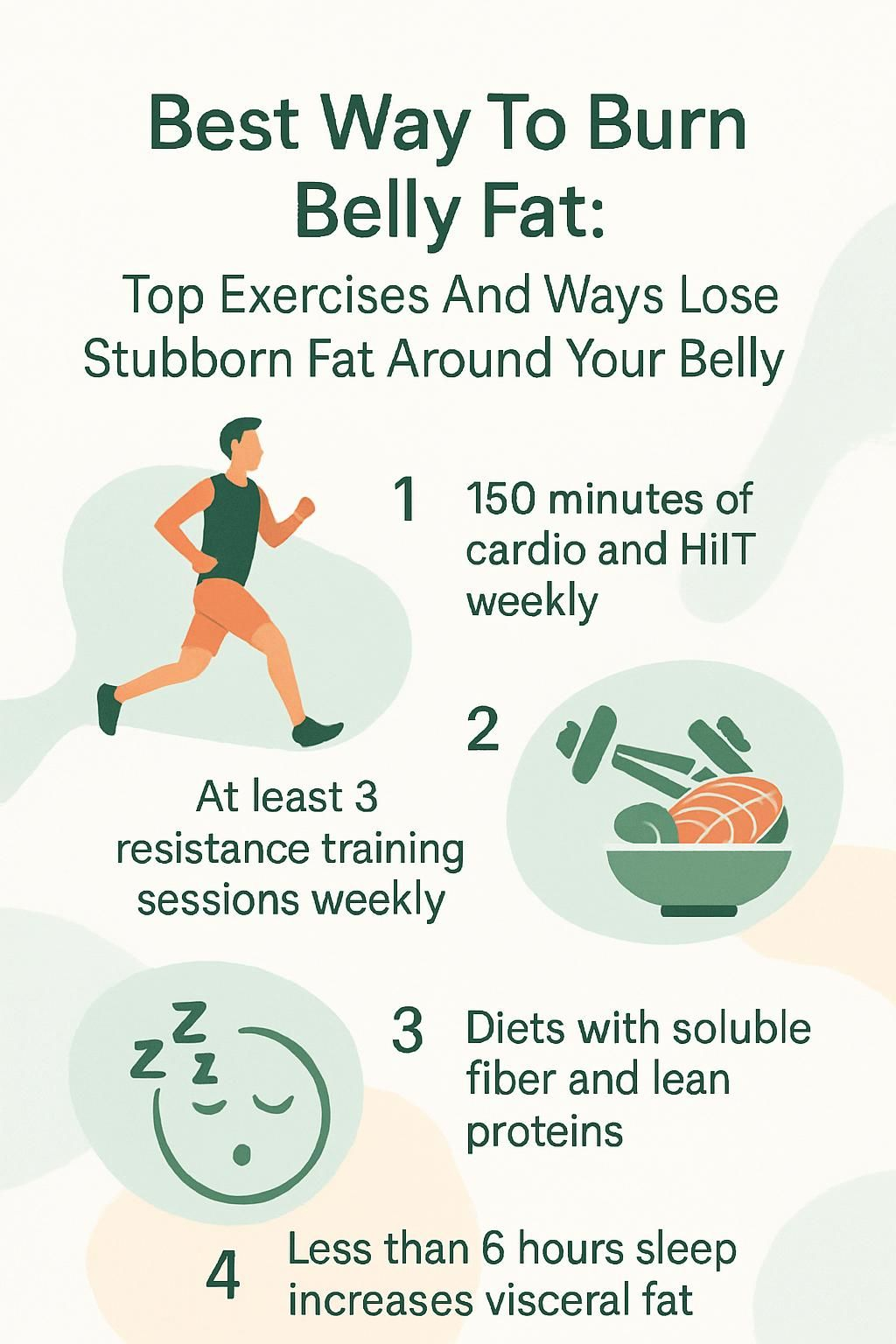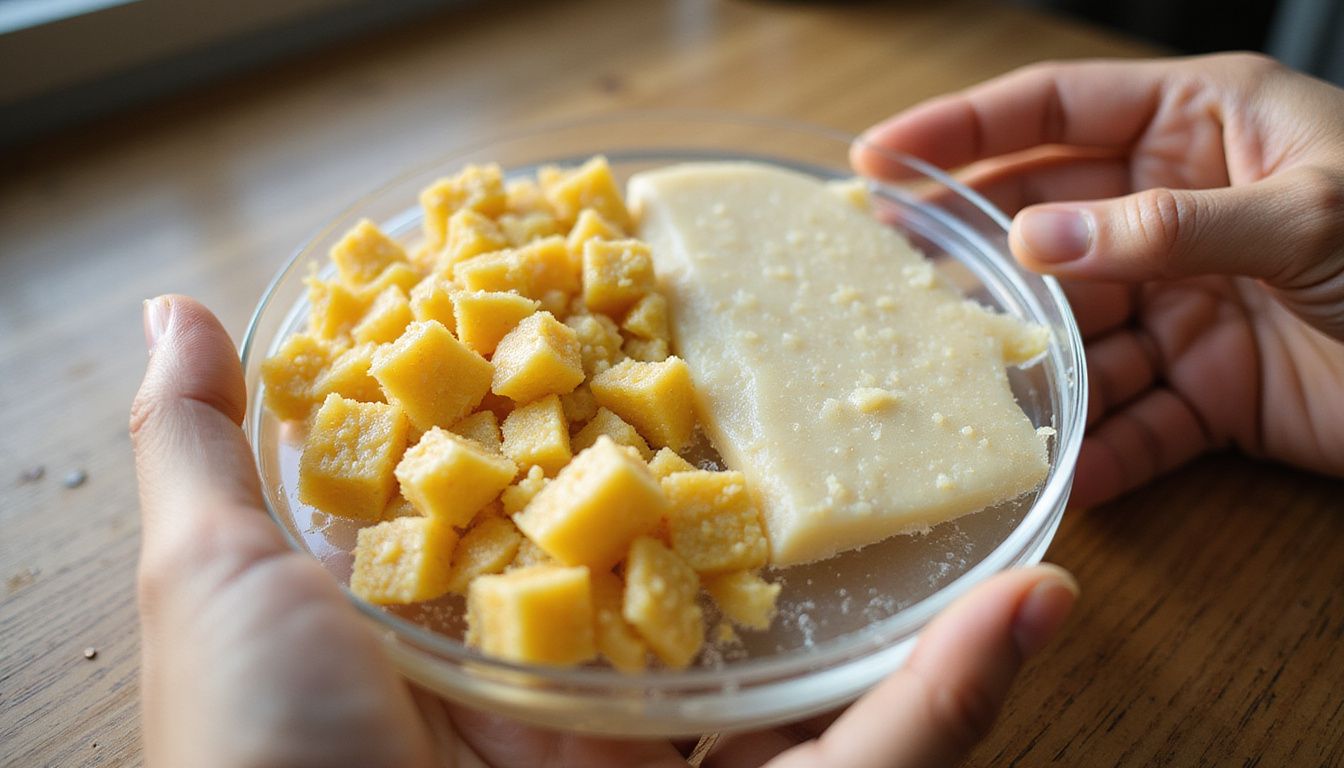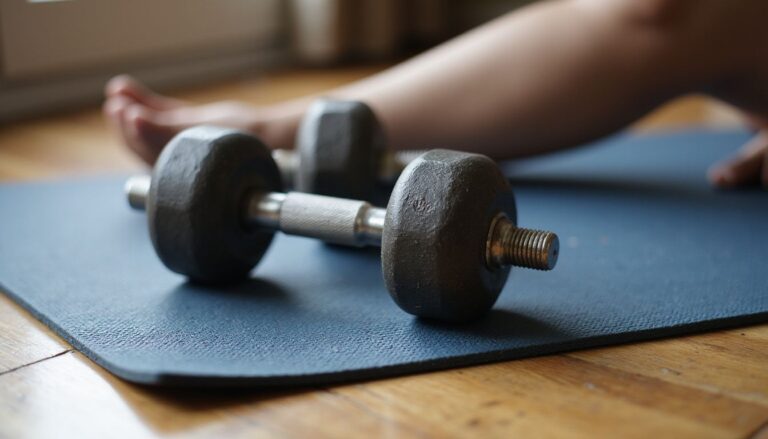Best Way To Burn Belly Fat: Top Exercises And Ways To Lose Stubborn Fat Around Your Belly
Our Nutrition Assistant AI Suite will transform your body. You will lose fat, get toned, and build muscle. Gain confidence and optimal health.
Trying to lose stubborn belly fat can drain your energy and confidence. Belly fat, especially visceral fat that sits deep around your organs, raises the risk of heart disease and type 2 diabetes.
This guide shows you practical ways to burn belly fat with proven exercises, smart nutrition, and simple daily habits backed by research. You will learn what helps most, how to build a plan, and how to track real progress.
Keep reading to see which steps make the biggest difference.
Key Takeaways
- Reducing belly fat works best with a steady calorie deficit, nutrient-dense foods, 150 minutes of cardio including some HIIT each week, and at least three resistance training sessions weekly (CDC Guidelines, Harvard Health 2022).
- Visceral belly fat raises the risk of heart disease, type 2 diabetes, high blood pressure, fatty liver disease, and insulin resistance, based on studies from 2015 to 2023.
- Diets high in soluble fiber, such as oats and black beans, and lean protein like chicken or fish, help shrink visceral fat while preserving muscle during weight loss.
- Heavy alcohol use and smoking promote visceral fat gain. People who quit smoking tend to store weight in safer places compared with ongoing smokers (Harvard T.H. Chan School of Public Health, 2018).
- Poor sleep increases cortisol, a stress hormone linked to abdominal fat storage. Adults who sleep under six hours often gain more visceral fat than those getting seven to eight hours (2022 study).

What Is Belly Fat and Its Types?

Belly fat collects around your midsection in two main forms. Knowing how each type behaves helps you choose the best strategies to lose belly fat safely.
What Is the Difference Between Subcutaneous and Visceral Fat?
Subcutaneous fat sits under the skin around the belly, hips, and thighs. You can pinch it. It serves as energy storage and insulation.
Visceral fat lies deeper inside the abdomen and wraps around organs such as the liver, pancreas, and intestines. You cannot pinch it, yet it has stronger links to disease.
Too much visceral fat increases risks for heart disease, insulin resistance, type 2 diabetes, metabolic syndrome, and some cancers. Hormone changes after menopause can shift more fat to the abdomen, which is why postmenopausal women often gain extra visceral fat.
Men and postmenopausal women are more likely to carry a higher share of intra-abdominal fat than premenopausal women. While both fat types count toward body mass index, reducing visceral abdominal fat delivers bigger health gains than only lowering subcutaneous fat.
What Health Risks Are Associated with Excess Belly Fat?
Carrying extra belly fat, especially visceral fat, raises your risk of long-term disease. This deep fat can increase blood pressure and harm heart and metabolic health. A waist over 40 inches for men or 35 inches for women is linked to higher rates of heart attack and stroke.
Experts, including the American Heart Association, report that abdominal obesity is tied to high cholesterol, fatty liver disease, and insulin resistance. Chronic stress can drive belly fat storage through higher cortisol levels. Visceral fat also releases chemicals that increase inflammation, which can damage blood vessels over time.
If you are overweight or obese, excess visceral fat can disrupt hormones that manage hunger and metabolism. Even a modest loss, supported by diet and exercise, helps lower these risks according to multiple studies from 2015 to 2023.
Summary Table: Health Risks Linked With Excess Belly Fat
| Risk Factor | Effect Seen in Studies |
|---|---|
| Cardiovascular Disease | Higher risk in people with large waistlines |
| Type 2 Diabetes | Greater blood sugar instability and insulin resistance |
| High Blood Pressure | More common in abdominal obesity |
| Fatty Liver Disease | Higher prevalence in overweight individuals |
| Insulin Resistance | Significant concern with extra belly fat |
Personal note: During college finals, my waist crept past the healthy range. I added brisk walking for 150 minutes a week and lifted weights twice weekly, and over time my waist and blood sugar both improved.
How Does Burning Belly Fat Work?
Your body burns belly fat through a steady calorie deficit, regular exercise, and healthy food choices. This combo reduces fat while helping you keep muscle mass.
How Does a Calorie Deficit Help Lose Belly Fat?
A calorie deficit means you eat fewer calories than your body uses. Your body then taps stored fat, including belly fat, for energy. Kept over time, both visceral and subcutaneous fat levels drop.
Studies show that people who lower calorie intake while staying active lose more total body fat and reduce waist size. Food choices matter too. Fiber-rich foods and lean protein help you feel full, which supports the deficit without constant hunger.
A consistent calorie deficit is the foundation for shrinking excess belly fat and improving health.
Tracking your meals reveals habits that slow progress, such as snacks that add up. Small course corrections add speed without feeling strict.
How Can Diet, Exercise, and Lifestyle Work Together to Burn Belly Fat?
Diet, exercise, and daily habits work best as a team. Aim for vegetables, fruit, lean proteins like chicken or beans, whole grains such as brown rice or oats, and healthy fats from nuts or olive oil. Soluble fiber may help reduce visceral fat. Strength training builds muscle, which raises the calories you burn, even at rest.
At least 150 minutes of moderate activity per week helps cut total body fat. Sleep and stress control matter as well. Poor sleep raises cortisol, which can push fat toward the abdomen. High stress can also hinder fat loss through hormone shifts.
Measuring your waist with a tape can show progress that the scale misses. I dropped two inches in three months by walking most mornings and swapping soda for water. Small steps, done often, add up.
Next, see which exercises help most with burning calories and strengthening your core.
Best Exercises to Target Belly Fat
Choose workouts that raise your heart rate and engage large muscle groups. They help you burn more calories and shape your midsection over time.
What Cardio Workouts Help Reduce Belly Fat?
Cardio raises your heart rate so you burn more calories. It improves fitness and supports fat loss across the whole body, which includes the abdomen.
- Running or jogging burns many calories. Aim for about 30 minutes at a steady pace most days.
- Brisk walking is joint friendly and great for beginners. Consistent walks lower waist size over time.
- Cycling makes your heart and legs work hard. A moderate 45-minute ride can burn several hundred calories.
- Swimming trains your whole body and builds endurance with minimal impact.
- High-intensity interval training, or HIIT, alternates hard efforts with short rests. It can reduce visceral fat faster than steady cardio.
- Rowing uses your legs, back, and arms at once. It boosts calorie burn and strengthens the core.
- Jump rope builds coordination and raises heart rate quickly. Ten to fifteen minutes can rival a longer run.
After a semester of sitting too much, regular runs trimmed my waist as my stamina grew. Consistency made the difference.
How Does High-Intensity Interval Training (HIIT) Burn Belly Fat?
HIIT uses short bursts of intense work with brief rest. This style burns many calories in less time and raises your metabolism after you finish.
- Hard intervals spike your heart rate so your body taps stored fat for fuel.
- All-out efforts push muscles to work harder, which increases total calorie burn.
- Just 20 minutes of HIIT can match longer moderate workouts for energy use.
- Post-workout burn stays higher for hours, which supports fat loss at rest.
- HIIT affects hormones, with higher adrenaline and lower insulin during sessions. This can reduce fat storage.
- You can do HIIT without equipment. Try sprints, fast step-ups, or bodyweight circuits.
- Short sessions, 15 to 30 minutes, make it easier to stay consistent.
- Research shows people doing HIIT three times per week lose more abdominal fat than those doing only steady-state cardio [1].
- Pairing HIIT with a balanced, lower-sugar diet can speed results.
Source: Boutcher SH, High-Intensity Intermittent Exercise and Fat Loss, J Obes. 2011;2011:868305.
What Strength and Resistance Training Exercises Are Effective?
Strength training builds muscle mass, which raises resting metabolism. More muscle helps you burn more calories all day, making it easier to reduce abdominal fat.
- Squats train the lower body and core. Add dumbbells for more challenge and a bigger burn.
- Deadlifts work the back, legs, and core at once. Stronger muscles support a higher daily energy use.
- Lunges target glutes, hamstrings, and quads while improving balance.
- Push-ups build chest, shoulders, triceps, and core with only body weight.
- Planks improve core stability, which supports better posture and form.
- Rows with dumbbells or bands strengthen the upper back and engage the core.
- Crunches train the front ab muscles. Combine them with cardio and full-body training.
- Overhead presses build shoulders and upper back strength that supports daily activity.
- Glute bridges train hips and lower back, which helps movement patterns and reduces strain.
When I added squats and rows four days a week, my waist tightened even though my diet stayed steady. Muscle made the difference.
Evidence: Resistance training three days per week can reduce visceral fat within three months (Harvard Health 2022, CDC Guidelines).
Which Core Exercises Best Target Belly Fat?
Core work strengthens the muscles around your midsection. These moves will not spot reduce fat, yet they shape and support your trunk while your diet and cardio handle fat loss.
- Planks train deep core muscles. Try 20 to 60 second holds with good form.
- Crunches target the rectus abdominis on the front of your abdomen. Aim for controlled reps.
- Bicycle crunches engage both upper and lower abs with a twisting motion.
- Mountain climbers combine core work with cardio for a quick burn.
- Russian twists train the obliques along your sides. Keep a neutral spine.
- Leg raises challenge the lower abs and hip flexors. Move slowly.
- Flutter kicks build endurance in the lower core. Keep your back flat.
Do these moves 2 to 4 times per week. Stronger abs support posture and help you perform other fat-burning exercises safely.
How Should You Adjust Your Diet to Lose Belly Fat?
Small, steady changes to your meals can shrink your waist and support long-term health. The goal is a calorie deficit with enough protein and fiber to keep you full.
Which Foods Are Rich in Soluble Fiber?
Soluble fiber forms a gel in your gut, which slows digestion and improves fullness. It may help reduce visceral fat over time.
- Oats, about 2 grams per half cup cooked. Try oatmeal with berries.
- Black beans, roughly 2 grams per half cup. Add to soups or salads.
- Brussels sprouts, close to 2 grams per cup cooked. Roast for a simple side.
- Carrots, about 1 gram per medium carrot. Keep sticks handy for snacks.
- Apples, around 1 gram each. Eat the skin for extra fiber.
- Avocados, about 2 grams per half fruit, plus heart-healthy fats.
- Flaxseeds, near 1 gram per tablespoon. Stir into yogurt or smoothies.
- Sweet potatoes, almost 2 grams per medium potato. Bake and season lightly.
- Barley, over 3 grams per cup cooked. Use it in grain bowls or soups.
- Citrus fruits like oranges, around 1 gram each. Keep the white pith when you can.
Swapping my afternoon snack for an apple helped curb cravings and kept my energy steady through late meetings.
What Are the Best Lean Protein Choices?
Lean protein helps preserve muscle as you lose fat. It also increases fullness so you eat fewer calories without feeling deprived.
- Chicken breast offers high protein with little saturated fat.
- Turkey breast has similar benefits and is versatile for meal prep.
- Fish like salmon, trout, or cod provide protein and omega-3 fats that support heart health.
- Eggs supply amino acids for muscle repair. Boiled or poached keeps calories in check.
- Greek yogurt delivers protein and live cultures that support gut health. Choose plain.
- Beans and lentils combine protein and fiber for long-lasting fullness.
- Nuts such as almonds or walnuts add healthy fats and a bit of protein. Watch portions.
Include a lean protein at each meal. Many people notice fewer cravings and steadier energy within a week.
Which Foods Should You Avoid to Reduce Belly Fat?
Certain foods make a calorie deficit tough or drive more visceral fat. Choose wisely most of the time to support your goals.
- Sugary drinks like soda and sweet tea add many calories without fullness.
- Processed snacks, including chips and pastries, are high in refined carbs and unhealthy fats.
- Fried foods raise total calories and can encourage visceral fat storage.
- Refined grains such as white bread and pasta digest fast and spike blood sugar.
- Alcohol can slow fat burning and add many liquid calories.
- Processed meats like bacon and some deli meats are linked to higher inflammation.
- Candy and ice cream load you with added sugars that crowd out nutrients.
- Fast food meals tend to combine excess sodium, sugar, and unhealthy fats.
- Energy drinks pack sugar and caffeine that can trigger crashes and overeating.
- Processed cheese products offer little protein but many calories from fat.
- High-sugar breakfast cereals are often marketed as light yet spike hunger later.
Why Include Healthy Fats and Whole Grains in Your Diet?
Healthy fats and whole grains help control hunger and support steady energy. They also aid cholesterol and blood sugar control, which ties to belly fat storage.
- Whole grains like oats, brown rice, and quinoa increase fullness with fiber.
- Healthy fats from nuts, seeds, avocados, and fatty fish supply essential fatty acids. Omega-3s may help reduce visceral fat.
- Balanced meals with these foods support stable blood sugar, which curbs fat storage.
- Whole grains add B vitamins that support metabolism.
- Diets higher in healthy fats can improve cholesterol profiles linked to heart risk.
- Nuts as snacks can replace ultra-processed options that promote weight gain.
- More fiber may reduce inflammation, helping your body respond better to training and a calorie deficit.
- These choices fuel workouts that burn calories and protect muscle mass.
- Swapping refined grains for whole grains helps limit insulin spikes tied to belly fat.
- Replacing saturated fats with monounsaturated or polyunsaturated fats often reduces waist size in studies.
- Adding these foods supports daily function and sustainable weight loss around your midsection.
How Does Alcohol Affect Belly Fat?
Your body treats alcohol like a toxin and prioritizes breaking it down. That slows fat burning. Drinks also add calories, which can push you out of a deficit.
People who drink heavily often carry more visceral fat. Sweet mixers and beer raise total calories quickly. A single pint can add about 180 to 200 calories. Alcohol can also increase appetite and reduce inhibition, which makes overeating more likely.
If you choose to drink, set a limit and plan food ahead. Seltzer with lime or a light beer saves calories compared with sugary cocktails.
What Lifestyle Changes Help Minimize Belly Fat?
Daily habits create the environment where fat loss either happens or stalls. Simple routines make your plan easier to follow.
How Can Stress Management Lower Cortisol Levels?
Stress spikes cortisol, a hormone linked to belly fat gain. Short sessions of deep breathing, meditation, or yoga can lower this response.
People who practice mindfulness often report less stress and smaller waistlines. Pair stress relief with regular exercise and solid sleep to improve appetite control and decision making around food.
Lower cortisol supports your calorie deficit and makes healthy choices easier to keep.
Why Is Quality Sleep Important for Belly Fat Loss?
Short sleep raises cortisol and disrupts hunger hormones, including ghrelin and leptin. That combination makes you hungrier and more likely to store fat around your waist.
A 2022 study found adults sleeping under six hours tended to gain more visceral fat than those getting seven to eight hours. Good sleep also helps preserve muscle during weight loss, which supports your metabolism.
Make a routine. Keep a consistent bedtime, dim lights an hour before bed, and keep devices out of the room if possible.
How Does Consistency in Physical Activity Affect Belly Fat?
Regular movement keeps your metabolism active. Cardio, HIIT, and strength training work together to raise calorie burn and protect muscle.
People who exercise most days typically lose more belly fat than those who are inactive. Daily choices like walking after dinner or taking the stairs add up. Dropping just 5 to 10 percent of body weight can reduce health risks tied to abdominal fat.
Steady habits matter more than perfect ones. Aim for progress, not perfection.
How Does Quitting Smoking Impact Fat Distribution?
Quitting smoking supports healthier fat distribution. While a small weight gain is common early on, former smokers tend to store less fat around the organs than continuing smokers.
Nicotine changes how your body stores fat, often driving more visceral fat. After quitting, keep up regular exercise and eat balanced meals with lean protein to protect your waistline.
I gained seven pounds in three months after I quit, yet my waist barely changed because I stayed active and tracked my meals. Research from Harvard T.H. Chan School of Public Health in 2018 supports this shift toward safer fat storage.
Advanced Strategies Beyond Diet and Exercise
Once your basics are set, these methods can provide a nudge. They are not magic, yet they can make your plan easier to follow.
How Can Intermittent Fasting Aid Belly Fat Loss?
Intermittent fasting limits eating to a daily window, such as 8 hours. During the fasting period, insulin drops and your body uses stored energy, which can reduce visceral fat.
Some people find it simpler than strict calorie counting. An eating window also trims late-night snacking. I used a noon-to-8 p.m. window and cut mindless snacks, which helped my calorie deficit.
As with any diet change, check with a healthcare professional if you have a medical condition, take medicines, or are pregnant.
Why Is Drinking More Water Important for Fat Loss?
Hydration supports metabolism and appetite control. Research in the Journal of Clinical Endocrinology and Metabolism found that drinking 500 milliliters of water can raise metabolic rate by about 30 percent for over an hour.
Thirst often feels like hunger. A glass of water before meals can help you eat fewer calories without feeling restricted. Keeping a refillable bottle at your desk is a simple way to stay on track.
What Are the Benefits of Probiotic-rich Foods for Belly Fat?
Probiotics support a healthy gut, which may influence body weight and waist size. Balanced gut bacteria are linked with better appetite control and less inflammation.
- Probiotic strains like Lactobacillus and Bifidobacterium may reduce waist measurements in some studies.
- These foods can help you feel full, which supports a calorie deficit.
- Options include yogurt, kefir, kimchi, and sauerkraut.
- Fermented foods can also help keep blood sugar steadier after meals.
- Some research links higher probiotic intake with healthier cholesterol and less visceral fat.
Adding kefir to breakfast helped me curb cravings before lunch and kept my meals more balanced.
How Do Omega-rich Fatty Fish Help Reduce Belly Fat?
Fatty fish such as salmon, mackerel, and sardines supply omega-3 fats. These fats can reduce inflammation and may improve insulin action, which helps control blood sugar and storage of belly fat.
Studies in 2019 found people eating two servings of fatty fish per week had less visceral fat. A four-ounce portion of cooked salmon has roughly 23 grams of protein, which keeps you full longer and supports muscle.
I began baking salmon twice a week. My energy improved, and my pants fit better at the waist within a few weeks. Pair fish intake with training for the best effect.
Reference: Javed et al., Nutrition Reviews, 2019.
Common Myths About Belly Fat Reduction
Plenty of myths promise quick fixes. Knowing the facts helps you focus on what works.
Is Spot Reduction of Belly Fat Possible?
No, spot reduction does not work. You cannot force fat loss from a single area by training only that area. Sit-ups will strengthen your abs, yet fat loss occurs across your whole body based on genetics, hormones, and your calorie deficit.
When I trained and improved my diet, my arms leaned out first. My stomach took longer. Focus on total-body training and nutrition. Your midsection will follow.
How Effective Are Supplements and Fat Burners?
Most fat burners offer small, short-term effects at best. Many rely on caffeine or green tea extract, which may raise calorie burn slightly, often 3 to 11 percent for a short period. Side effects like poor sleep, jitters, and stomach upset are common.
I tried a popular fat burner before summer. I felt wired but saw little change in my waist. Your best results come from a calorie deficit, protein, fiber, and consistent training. Use supplements with care, and talk with a healthcare professional if you have medical concerns.
How to Measure Belly Fat Loss Progress
Tracking makes your plan measurable and motivating. Use more than one method for a clearer picture.
Should You Track Inches Lost or Weight Loss?
Both inches and weight matter, and each tells a different story. During a 12-week cut, I lost only three pounds but trimmed two inches from my waist. That showed better body composition even when the scale barely moved.
| Criteria | Tracking Inches Lost | Tracking Weight Loss |
|---|---|---|
| What It Measures | Change in circumference around waist, hips, and other key areas | Overall body weight on a scale |
| Main Benefit | Shows fat reduction where it matters, like the belly | Gives a broad view of mass changes, including water, fat, and muscle |
| Limitations | Technique can vary, and it may not reflect muscle gain | Cannot separate fat, muscle, and water changes |
| Motivation Factor | Smaller waist numbers boost motivation even if weight stalls | Sudden shifts can feel discouraging due to water or muscle changes |
| Recommended For | Anyone focused on visual and functional changes, especially during strength training | People tracking large-scale loss or overall health |
| Frequency | Once weekly for accuracy, measure the same spot each time | Once or twice weekly, weigh at the same time of day |
| Evidence | Waist circumference predicts heart risk better than BMI in many cases (Harvard Health, 2022) | Useful for long-term trends but can miss body composition changes (CDC, 2021) |
Can Clothing Fit Indicate Belly Fat Reduction?
Yes. Looser waistbands and easier buttoning often show fat loss before the scale moves. As visceral and subcutaneous fat drop, your clothes usually fit better.
My first sign was using an extra belt notch after weeks of steady cardio and HIIT. Combine clothing fit with tape measurements for clear feedback.
FAQs About Belly Fat Reduction
These quick answers cover common questions and point you to practical steps.
What Foods Best Target Belly Fat?
Foods high in soluble fiber can help, such as oats, flaxseeds, avocados, Brussels sprouts, black beans, and apples. A higher fiber intake is linked with less belly fat gain over time. Lean proteins like chicken breast, turkey, tofu, lentils, and Greek yogurt support fullness and muscle.
Berries help control blood sugar, which limits cravings. Whole grains like brown rice and quinoa supply steady energy. Nuts and seeds provide healthy fats that may reduce inflammation. Limit processed foods with added sugars and trans fats, since they can raise visceral fat quickly.
Swap refined carbs for whole grains. Add berries to breakfast. These small changes make meals more filling without feeling strict.
How Long Does It Take to See Belly Fat Loss Results?
Many people notice changes in 4 to 8 weeks after starting a routine with a calorie deficit, cardio, and strength training. Your starting point, age, and consistency all affect timing.
A 500-calorie daily deficit often leads to about a pound per week of weight loss. Pair that with regular workouts and whole foods, and your waist may slim sooner. I saw results a little after one month with daily walks and three HIIT sessions per week. Measure your waist and watch how clothes fit, not just the scale.
Conclusion
Burning belly fat takes steady habits, not perfection. Create a calorie deficit with balanced meals, then pair it with regular cardio and strength training. These steps reduce visceral fat and protect muscle mass.
Build meals around protein, fiber, and healthy fats. Track progress with waist measurements and clothing fit, not just scale weight. Support your plan with stress management, solid sleep, and enough water.
If you have a medical condition or take prescription medicines, talk with a qualified healthcare professional before changing your diet or exercise routine. With patience and consistency, your waistline and health can improve in lasting ways.
FAQs
1. What are the most effective exercises to burn belly fat?
Aerobic activities like brisk walking, cycling, and swimming help reduce abdominal fat. Strength training with compound movements such as squats and deadlifts also supports muscle growth and increases metabolism. High-intensity interval training (HIIT) can further boost calorie burning according to research from Harvard Medical School.
2. Can diet changes help lose stubborn belly fat?
Yes, reducing added sugars and refined grains while increasing fiber intake aids in losing visceral fat around your waistline. Studies show that diets high in protein support satiety and preserve lean mass during weight loss efforts.
3. How long does it take to see results from exercise for belly fat reduction?
Visible changes depend on consistency, genetics, age, and starting body composition. Most people notice a difference within eight to twelve weeks of regular aerobic activity combined with healthy eating habits based on data published by the National Institutes of Health.
4. Are targeted abdominal workouts enough for losing stomach fat?
Spot reduction is not supported by scientific evidence; doing only sit-ups or crunches will not remove subcutaneous or visceral adipose tissue specifically from your midsection. A combination of full-body movement routines paired with dietary adjustments produces better outcomes for overall body composition improvement.
Summary: Aerobic exercise, strength routines using compound lifts, HIIT sessions, balanced nutrition plans rich in protein and fiber all contribute to reducing excess abdominal tissue over time when practiced consistently alongside lifestyle modifications backed by credible studies.







